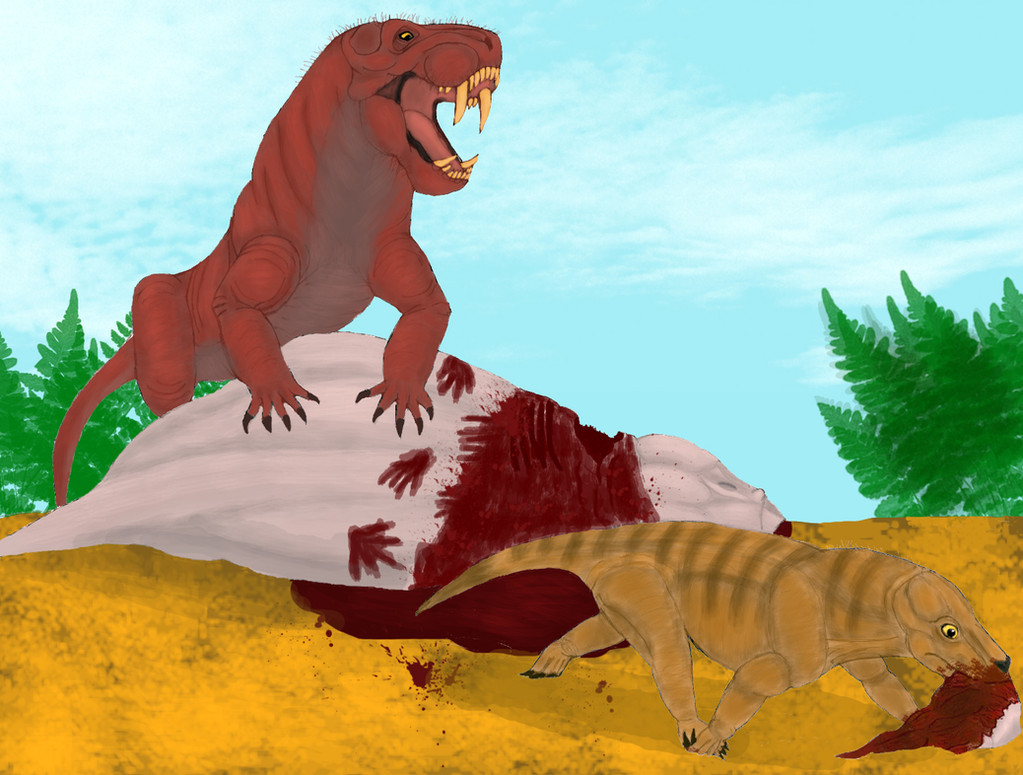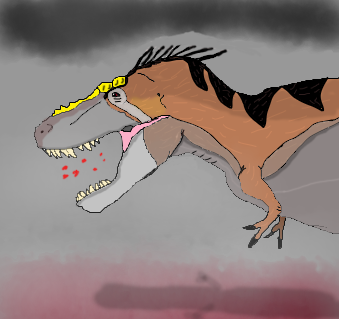HOME | DD
 Innerwolf88 — Permian bully
Innerwolf88 — Permian bully

Published: 2010-06-10 20:24:53 +0000 UTC; Views: 2363; Favourites: 23; Downloads: 39
Redirect to original
Description
Another attempt at paleoillustration, this time with quite a lot of research( with the unvaluable help of ) behind it.What you see is a scene from the Late Permian in what we nowadays know as South Africa.
A Moschorynus kitchingi (a therocephalian; to the right) managed to kill an ill Aulacocephalodon ( an anomodont, to the center) with his powerful bite to the neck.
However, a bigger, stronger predator, a Dinogorgon rubidgei(a gorgonopsid, to the left) wanted an easy meal and approached the scene trying to intimidate the therocephalian.
To avoid potentially grievous wounds, the Moschorhinus takes a chunk of flesh from the carcass and run to safety.
The scene is completely speculative, but I wanted to reflect an interesting fact: predators trend to increase in size is believed to be directed( amongst other factors) by the selective pressure of dominating intra- and inter-specific conflicts over carcasses.
Biggest guy gets the pie ^^
My next step in the process of learning to paint digitally. I know the blood came messy and undefined, but it was my first attempt and I'm pleased with the rest of the composition.
Please, give me your comments. Opinions, feedback, whatever. I will let you hug the sad Moschorhinus! XD
Related content
Comments: 19

'Terribly fierce' reigns true to this erethrystic gorgonopsid
👍: 0 ⏩: 0

I just read something about Porosteognathus, a therocephalian with some sort of bony crest which it might have used for head-butting:
[link]
I thought you might like it as we talked about gorgonopsids with a possible head crest as the therocephalians and gorgonopsians are pretty closely linked.
Have there actually any remains of gorgonopsids been found in the earliest Triassic layers? Just as some large therocephalians such as Moschorhinus did survive the extinction, I think that might have been possible for small-medium sized gorgonopsids, don't you?
👍: 0 ⏩: 1

Very interesting.
On that drawing you can see what I tried to achieve with the Moschorhinus nose. Differently coloured but not fully developed.
I had a quite complete table of therapsid fossile record over time, if I find it I will check (and send it to you). It does seem possible, but there could have been differences in methabolism (or other non fossilized traits) deep enough to make gorgonopsid unsuitable for the post-extinction world but not therocephalians.
👍: 0 ⏩: 1

I'd love to see it!
You did a great job on this one, though! Therapsids are very hard creatures to draw, so I don't draw them very ofen. Keep the good work up!
👍: 0 ⏩: 0

Moschorhinus shouldn't be so sad! He is a lucky bastard! In the Triassic he is the top predator, so I'll hug the Dinogorgon (my favorite gorgonopsid), as he's the one to be extinct soon! Very nice idea, a fight between a therocephalian and a gorgonopsid! My compliments! By the way, is the sky a photograph or painted digitally? If the latter is true, what program do you use?
👍: 0 ⏩: 1

Looking at it like that, he who laughs last laughs best ^_^
Thanks,I always thought it would be interesting to paint two members of two of the major therapsid lineages interacting around a carcass.
The sky is digitally painted, using Photoshop CS 5 an a set of pre-made cloud brushes. You can find several of the latter on Deviantart and download them from here. It looks pretty effective but it's very easy!
👍: 0 ⏩: 1

Unfortunately I have no photoshop. I mainly draw with Sumopaint and just Paint. So I guess the ferns are also pre-made brushes, or am I wrong?
Next:Gorgonopsid v.s. Dinocephalian and Cynodont v.s. Therocephalian!
Although you're probably a better artist than me, I still have some feedback:
I think the Aulacocephalodon and the Dinogorgon should have had a more natural colour, more like grey, brownish, or maybe a sand-like colour.
I also think the scene looks a bit flat, like there's no real background.
And I'm also a little wary about the dog-like nose of the Moschorhinus. Being a therocephalian it was closely related to the gorgonopsid and I think thus it had a more similar (so probably more reptilian) nose. I personally think that the dog-like nose evolved just in carnivorous mammals, not even in cynodonts, but that can also be seen as a personal flavour.
I hope you can use my comments in some way and if you don't agree with them you should of course do it your way.
Regards!
👍: 0 ⏩: 1

Then I can't help you. Maybe you should pick it if you intend to bring your art to next levels. The ferns are just the same. I could have tried drawing them the hard way but I don't put much attention to backgrounds, they are only here to give the animals a context.
You are right in that the Dinogorgon has a pretty exotic colour scheme, but I have seen tons of prehistoric animals (mainly dinosaurs) done that way, and I wanted to have some fun. I don't see what's wrong with the Aulacocephalodon, he is light grey.
The scene happens in a plain, with no elevations or forests in the vicinity. I don't really know how could I have conveyed such a landscape while making it less "flat".
That dog-like nose (I don´t think it's that exaggerated, I intended it to be a subtle touch) is an artistic license, but one I have seen used and abused around here. Therocephalians could be considered closer to cynodonts than to gorgonopsids, as both are more derived. And dog-like noses are pretty well supported for the former.
Thanks for taking the time to comment and suggest me some advice. If you upload creature drawings I will try to do the same.
👍: 0 ⏩: 1

Well I think it is quite possible for some feathered dinosaurs to have some exotic colous, especially males. Still I think that in such an environment (mainly sand) there was nowhere to hide, so a sand-like colour of the Dinogorgon would seem enough to me to mislead the eyes of big dicynodonts and pareiasaurs which were probably relatively weak. I thought the Aulacocephalodon was more pink, but it is indeed a bit pink-greyish. Still I would do it a more greyish colour still, but that's probably just my personal flavour.
I think the scene should continue some higher up in the drawing with maybe some mountains or some very small fern-trees in the background to make it look more like a plane. In this position it looks to like the scene is playing on a hilltop and that's the reason you don't really see any further background. That's mainly because the ferns are behind the soil in the drawing.
I tend to think cynodonts and especially therocephalians are often pictured too mammal-like and that they were more reptilian in real life. I think that most therapsids would have had leathery skins and that hairs did not appear until the therocephalians and cynodonts and that whiskers did not appear until the galesaurids and thrinaxodonts. I am convinced though, that the pinnae appeared relatively early and that gorgonopsids already may have had relatively well evolved pinnae. I think that small pinnae already evolved in the first biarmosuchians, just as endothermia.
Although not many artists do it, it is not all too unlikely for male gorgonopsids to have had medium sized to even big cartilagonous crests on their skulls, that during mating time might have gotten brightly coloured. Some gorgonopsids have a small (almost invisible) ridge running along their skull. One might speculate that a brigtly coloured crest was attached to this tiny ridge. It would give a revolutionary impression of gorgonopsids as never seen before. Nice idea?
Regards!
👍: 0 ⏩: 1

See, adding pinnae would give gorgonopsids a very interesting appearance.
As would do such cartilaginous crests. But is that part purely speculative or has it serious evidence beyond the small ridge on skulls?
👍: 0 ⏩: 1

Well unfortunately this crest in gorgonopsids and also sebecid crocodylomorphs is very speculative (but surely possible). In the dinosaur Rugops, though, such ridges were found on both sides of the skull. Scientific research had as an outcome that this abelisaur may have had two small Dilophosaurus-like crests running along its skull, although the direct evidence therefore has never been found. Still it was very likely in this dinosaur.
Unfortunately not gorgonopsids nor sebecids have had such research (although dinocephalians did, which proved that some anteosaurs may have had large crests). I think a crest would look cool on pretty much any carnivorous animal
👍: 0 ⏩: 0

Thanks, I thought it was a good idea even when it ended a bit goofy ^^
👍: 0 ⏩: 0





























